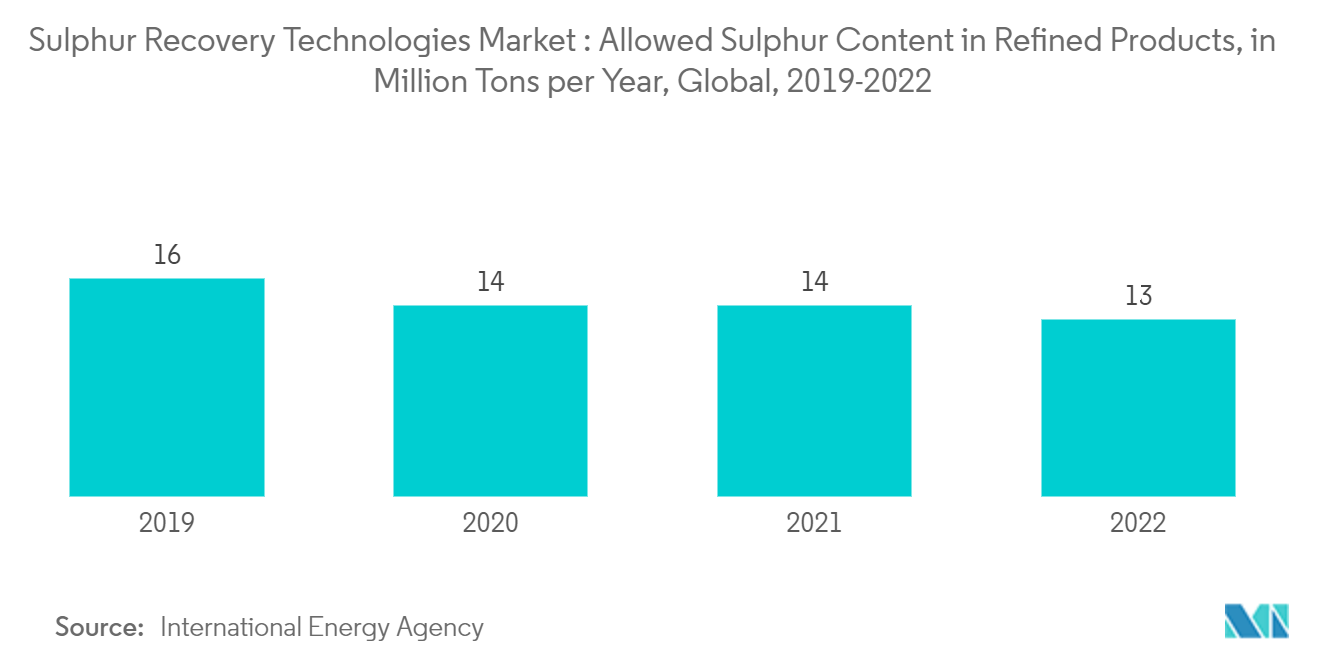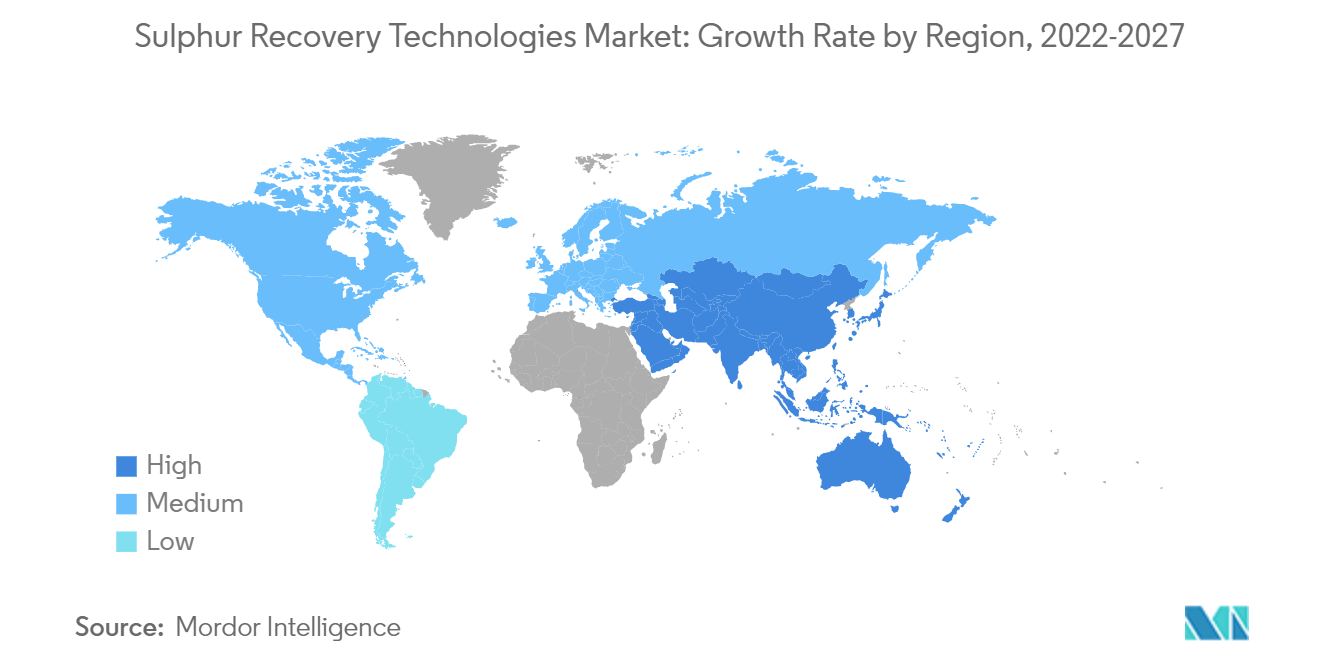Market Trends of Sulphur Recovery Technologies Industry
This section covers the major market trends shaping the Sulphur Recovery Technologies Market according to our research experts:
Refineries Segment Likely to Dominate the Market
- The refineries are a key end-user of sulphur recovery technologies, as the Sulfur Recovery Unit (SRU) is extremely vital in the Refinery in recovering sulfur. For example, reducing the sulfur content in gasoline and diesel improves emission controls and reduces air pollution when the products are used.
- Refineries are expected to dominate the sulphur recovery technologies market in the coming years owing to the increasing investments in expanding the oil & gas refining plants and the growing environmental awareness and regulations globally.
- New regulations, especially in the transportation segment under the IMO rules, 2020, heavily focus on decreasing sulphur content in the fuel. For ships operating outside designated Emission Control Areas, IMO has set a limit for sulphur in fuel oil used on board ships of 0.50% m/m (mass by mass). More refining of crude oil is expected to boost the sulphur recovery market.
- In 2021, the total global oil refining capacity has reached 36,478 thousand barrels per day, recording a slight increase from 36459 thousand barrels per day in 2020. Most of the capacity has come from the countries such as the United States, China, India, Japan, Saudi Arabia, and other ASEAN countries. Further, the countries are primarily dependent on hydrocarbons and hydrocarbon-derived products.
- In recent years, several countries are making significant developments in expanding and upgrading their oil refinery units, including sulphur recovery technologies, to cater the future demands. For instance, in September 2022, the energy and infrastructure business unit of Nuberg Engineering announced it is set to build an INR 650 crore SRU for Indian Oil Corporation (IOC) as part of the latter's expansion plans at the Koyali refinery and petrochemical complex.
- In 2021, the state-owned IOC signed a memorandum of understanding (MoU) with the Government of Gujarat to add petrochemical and lube plants to its previously announced plans to expand crude oil processing capacity at Koyali refinery at Vadodara. IOC is in the process of developing refining capacity by 4.3 million tonnes per annum to 18 million tonnes per annum, along with plants to produce 500,000 tonnes per annum of polypropylene and 235,000 tonnes of lube oil base stock as part of its petrochemical and lube integration (LuPech) project and acrylics/oxo alcohol project at Koyali. The total investment at Koyali will be to the tune of around Rs 24,000 crore.
- Therefore, with the increase in demand for clean fuel, the global sulphur recovery technologies market is expected to increase considerably during the forecast period.

Asia-Pacific to Dominate the Market
- Asia-Pacific is one of the fastest-growing regions in the world, owing to the presence of emerging countries, like India and China, and developed countries, such as Japan, South Korea, and Australia. As of 2021, the Asia-Pacific region is one of the significant regions in the global Sulphur recovery technologies market and is likely to continue its dominance during the forecast period, owing to the rapid growth in energy-intensive industries like refineries in the region.
- In 2021, China is the world's 2nd largest oil consumer but the 6th largest oil producer. The country imports nearly 50% of its hydrocarbon demand to reduce dependence on imports and improve energy security. China has been trying to maximize its shale potential by exploiting its domestic reserves across various inland shale basins, such as the Sichuan basin. The shale gas development in China has increased steadily in the past few years, growing 21% annually since 2017. In 2021, shale gas production totaled about 2.2 Billion cubic feet per day (Bcf/d), below the government target of 2.9 Bcf/d by 2020.
- The shale revolution in China has resulted in unprecedented petrochemical capacity creation and expansion. As a result, China has made significant investments in refining and petrochemical infrastructure to placate domestic demand and reduce the petrochemical process for domestic industries. Due to an ever-rising demand for plastics and other petrochemicals from food packaging, clothing, cosmetics, and fertilizers, refining capacity must be increased to handle the growing demand.
- China has accepted the new IMO guidelines and is expected to further aid the growth of sulphur recovery technologies by increasing its investments into the modernization of the refining sector. Also, China is also building new refineries and upgrading and adding capacity in older refineries. As of 2021, nearly 1.8 million bpd of new refining capacity is under construction in China, with most expected to come online in 2022. In addition, expansion and upgradation operations are ongoing at multiple refineries in the country.
- Further, in mid-2022, PetroChina launched a USD 4.52 billion programs to expand a subsidiary refinery in southern China into an integrated petrochemicals complex. The country's second-largest state refiner is expected to keep crude oil refining capacity at the Guangxi Petrochemical plant unchanged while adding 14 major petrochemical units. Such investments are expected to boost the demand for sulphur recovery technologies in the coming years.
- Moreover, in March 2022, Thermax Ltd, an Indian multinational engineering conglomerate, has concluded an order of USD 149.02 million from an Indian public sector refinery to set up their sulphur recovery block on LSTK basis. The sulphur recovery block will be a part of the customer's ongoing refinery expansion project. This landmark project is being pursued as a part of the government of India's North East Hydrocarbon Vision 2030.
- Hence, the Asia-Pacific region is expected to dominate the market due to its large oil and gas refining sector and increasing demand for cleaner fossil fuel.

